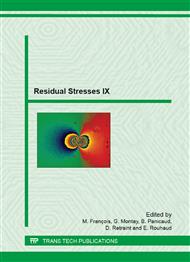p.187
p.192
p.197
p.203
p.209
p.215
p.221
p.228
p.234
Gamma Profile Analysis for Stress, Texture and Grain Size
Abstract:
Two-dimensional X-ray diffraction pattern can be described by the diffraction intensity distribution in both 2θ and γ directions. The 2D pattern can be reduced to two kinds of profiles: 2θ-profile and γ-profile. The 2θ-profile can be evaluated for phase identification, crystal structure refinement and many applications with many existing algorithms and software. The γ-profile contains information on texture, stress, and crystal grain size. This article introduces the concept and fundamental algorithms for stress, texture and crystal size analysis by γ-profile analysis.
Info:
Periodical:
Pages:
209-214
Citation:
Online since:
August 2014
Authors:
Keywords:
Permissions:
Share:
Citation:


